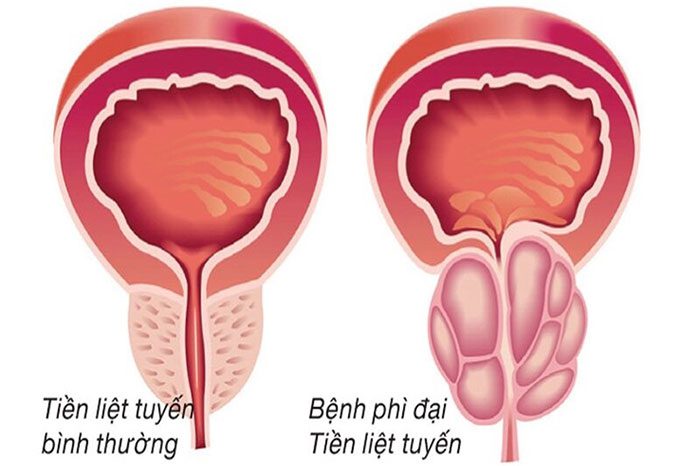Benign Prostatic Hyperplasia (BPH), also known as prostate enlargement, benign prostatic hyperplasia, or benign prostatic hypertrophy, is a common condition affecting the prostate gland in men.
Essential Information About Benign Prostatic Hyperplasia
The prostate gland is a small gland, weighing about 10-20 grams, found only in men. It is located just below the bladder and surrounds the urethra at the point where it connects with the bladder neck. The primary function of the prostate gland is to produce a fluid that aids in male reproduction, as well as to block toxins, bacteria, and chemicals from entering the urinary tract.
Benign prostatic hyperplasia is characterized by an increase in the size of the prostate gland, particularly in middle-aged and older men, which compresses the urethra and bladder, leading to urinary disorders such as: difficulty urinating, urinary retention, frequent urination, urgent urination, intermittent urination, incomplete bladder emptying, and complications like urinary tract infections and kidney function impairment, all of which negatively impact quality of life.
BPH typically begins to develop around the age of 30, but symptoms usually appear after the age of 50. It is less common in younger individuals. The prevalence of the condition increases with age, with more than 50% of men over 50 years old affected.
Benign prostatic hyperplasia is a benign condition that can be completely cured and does not lead to prostate cancer. However, prostate cancer may be detected concurrently with benign prostatic hyperplasia.

Causes of Benign Prostatic Hyperplasia
The exact cause of benign prostatic hyperplasia is not entirely clear. Some studies suggest that with aging, sexual function declines, leading to a hormonal imbalance characterized by decreased testosterone and increased estrogen, which may contribute to prostate enlargement.
Symptoms of Benign Prostatic Hyperplasia
- Frequent urination, especially at night, leading to sleep disturbances, and an urgent need to urinate that cannot be postponed for more than a few minutes.
- Difficulty urinating, requiring straining to initiate urination, intermittent urinary flow, weak urine stream, and dribbling after urination, which may wet clothing.
- Discomfort after urination, with a persistent feeling of incomplete emptying.
- Shortened intervals between urination.
- Urinary retention: an inability to urinate suddenly despite straining, causing significant discomfort in the lower abdomen, necessitating immediate medical attention.
The symptoms of benign prostatic hyperplasia may develop gradually and may not correlate with the size of the prostate, with some cases presenting subtle symptoms despite significant enlargement. Therefore, early detection through medical examination is crucial.
Individuals at Risk for Benign Prostatic Hyperplasia
- Men over 50 years of age
- Family history of benign prostatic hyperplasia
- Obesity and lack of physical activity
- Ethnicity: Caucasian and African American men are at higher risk
- Lifestyles involving excessive alcohol consumption, smoking, and low water intake, along with diets high in fat.
- Erectile dysfunction
- Diabetes, heart disease, and use of beta-blockers
- Other factors: working in polluted environments, chronic stress, and a history of urinary tract issues.
Prevention of Benign Prostatic Hyperplasia
Men aged 50 and older experiencing urinary disorders should seek timely medical evaluation and treatment.
Diagnosis Methods for Benign Prostatic Hyperplasia
- Digital rectal examination: detects significant prostate enlargement and estimates the size of the prostate.
- Ultrasound: assesses the size and volume of the prostate.
- PSA test: a cancer marker. Normal PSA levels are less than 4 ng/ml. If PSA levels exceed 10 ng/ml, the likelihood of cancer is higher than that of benign enlargement.
- Other tests: blood tests, urine tests if infection is suspected, and biopsy if cancer is suspected.
Treatment Options for Benign Prostatic Hyperplasia
Medical Treatment
Benign prostatic hyperplasia can be treated medically with medications that alleviate symptoms; however, no medications have been proven to reduce the size of the prostate.
Surgical Treatment
Surgical intervention is the primary treatment method when medical management fails or if complications arise, including: prostatectomy, transurethral resection, and additional methods such as water vapor therapy, laser surgery, microwave thermotherapy, and ethanol injection.




















































